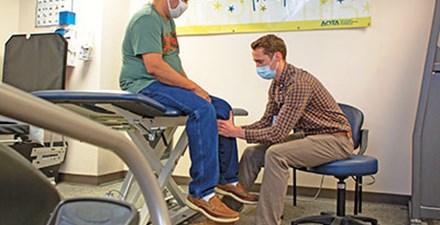Aside from taking oral analgesics, patients with osteoarthritis (OA) may be underusing nonsurgical therapies such as physical therapy, say authors of a recent study published ahead of print in Arthritis Care & Research (abstract only available for free). The use of physical therapy, a guideline-recommended first-line treatment, is “a key area for improvement,” researchers write.
While 70%–82% of participants in 3 clinical trials had used oral analgesics to treat OA symptoms, only 39%–52% had used physical therapy. Other treatments included knee injections (55%-60%) and topical creams (25%–39%). Most participants had used more than 1 type of treatment.
Yet clinical practice guidelines for OA, authors note, first recommend nondrug interventions such as “self-management education, weight-loss, and physical activity, along with pharmacologic therapy when tolerated and safe.”
In the study, researchers sought to identify what, if any, patient demographic and clinical factors were associated with use of these guideline-based nonsurgical interventions, as well as how frequently interventions were used. They analyzed data from 3 clinical trials affiliated with Duke University Medical Center primary care practices (PRIMO-Duke), Durham Veterans Affairs Health Care System (PRIMO-VA), and University of North Carolina–Chapel Hill (PATH-IN).
While physical therapy use was only moderately used, it was still higher than in previous studies, researchers write. They suggest that this difference could be due to older studies being based on referral data from single providers, as opposed to self-report data from patients, who may have been referred by more than 1 provider. Still, authors observe, with just 39%–52% of participants receiving a therapy that is recommended as a first-line treatment, this is “a key area for improvement in OA treatment.”
Among pharmacologic treatments, the use of NSAIDs, other nonopioids, and opioids aligned with clinical practice guidelines. Opioids are recommended as the last resort for managing OA symptoms; however, opioid use was higher among veterans than in the other 2 clinical trials, “suggesting a gap in OA treatment guidelines and opioid use for OA among veterans,” say authors. However, researchers were unable to determine whether veterans who used opioids did so because NSAIDs either had failed to relieve pain or led to side effects.
Across all 3 studies, nonwhite participants, on average, were more than twice as likely as white patients to have used topical creams. But authors found that no other “single clinical or socio-demographic participant characteristic was consistently associated with any specific OA treatment.” They also note that other characteristics were associated with use of multiple treatments, including being female, being nonwhite, having higher BMI, and having pain scores. Other patient demographics analyzed include income level, age, “fair/poor self-rated health,” years with symptoms, knee OA, and hip OA.
The results of the study, say researchers, suggest “potential adherence to OA treatment guidelines for oral analgesics” but also indicate “areas for improvement in opioid use, [physical therapy], and joint injections.”
“It is imperative that we understand not only how to best manage OA but also how to implement evidence-based guidelines for OA management in the community considering individual demographic and clinical characteristics to reduce the burden of OA pain and disability,” authors write.
Research-related stories featured in PT in Motion News are intended to highlight a topic of interest only and do not constitute an endorsement by APTA.
